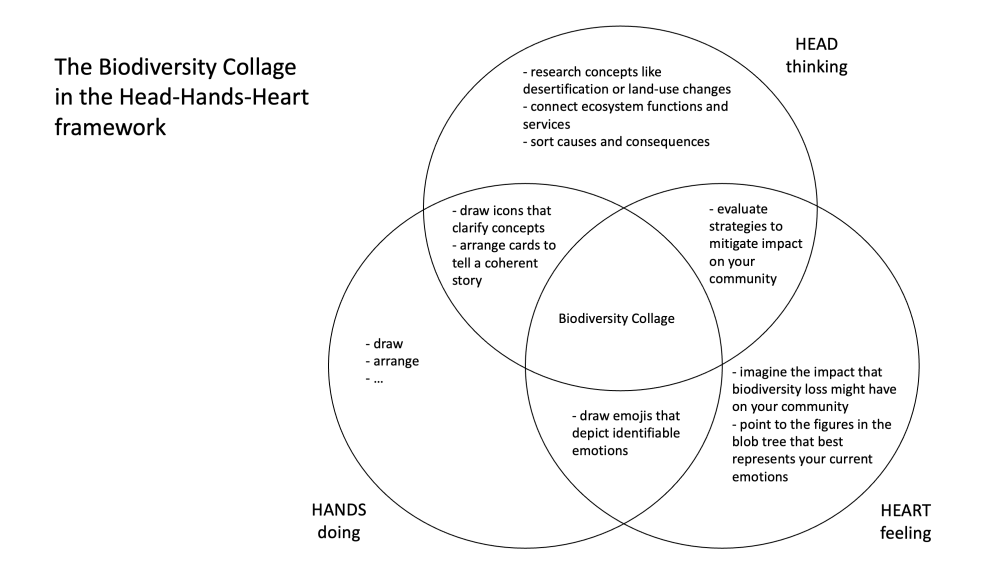One framework that seems to be very helpful when planning teaching about sustainability is the “head, hands, and heart” framework. I am using the term “framework” loosely — it is basically a Venn diagram of three overlapping areas:
- intellectual aspects: the “thinking” part that most of university teaching focusses on and that we as teachers probably feel most comfortable with. Typical activities might be listening to lectures, reading scientific articles, writing reports, solving practice exercises in groups, maybe keeping learning journals
- practical aspects: the “doing” aspects that are a lot less common in most study programs. Maybe there are some skills that are being taught, like using a software to design a poster that efficiently conveys information, building sound structures out of materials that are provided, using specific measurement instrumentation
- emotional aspects: the “feeling” aspects that many teachers try to not get too close to, but that could include for example reflecting on values or how it feels to work in a specific group, learning how to deal with conflicts in group work, or how to motivate yourself to do something you aren’t yet motivated to do
Where these areas overlap, things get a bit more interesting.
- Head and hands combines for example designing and building, reading an instrument manual and operating the instrument, …
- Head and heart combines for example intellectually understanding a topic and translating it into a science poem, designing a questionnaire to figure out what needs a specific community has, …
- Hands and heart combines making something for someone else’s benefit
- Lastly, where head, heart, and hands overlap, students do something that is intellectually challenging and stimulating, but where they also get into the practical implementation of creating a tangible outcome that is connected to a cause and a community they care deeply about. This is what we want to aim for when teaching about sustainability, it is here that the magic is happening, students are engaged and transformed.
This framework was developed by several teams of authors independently of each other and through very different approaches, which only strengthens it in my eyes.
For Sipos et al. (2008), it was a pragmatic approach to integrating sustainability in existing curricula and still achieving transformative learning. They have two premises: 1) Students’ learning is localised, both at university in a formal context, where it is often broken into distinct subjects that are taught completely independent of each other, and in the rest of their lives, i.e. their homes, leisure-time activities, etc. This will lead to conflicts between what is learned in different contexts, unless 2) learning is situated across all those contexts in the first place, and university purposefully integrates all the non-university contexts with the other relevant communities.
Öhman and Sund (2021) develop a similar framework based on educational theories and postulate that sustainability commitment is found where the three areas overlap.
So how can this framework be useful for teachers?
Firstly, just talking about it helps raising the importance of challenging students in more areas than just intellectually, and generating conversations about how this can be done in general and more specifically. Many teachers want to support students in their emotional development and engage them in activities that are meaningful to them, but don’t necessarily feel equipped or allowed to do so.
Then, this framework is helpful as a tool to reflect on our own teaching. If we map all the activities in our course onto the different areas, are there any in the hands and hearts parts, and where the two overlap?
Lastly, it can be very useful to do a similar mapping exercises with planned teaching to check which aspect our focus is on. Most likely the intellectual part, and that’s ok! But maybe there are ways we can and want to add in some emotions or practical aspects? Or, as in the image above that maps the activities in the serious game “Biodiversity Collage” (see here for our event summary), the “hands” part is really not very inspiring. Which is true — there is really no artefact being produced that has any impact beyond the workshop itself (except if you use the collage like Léa did: she has done a competition around the best-annotated collage, which she then uses throughout the semester as organiser and to put content in the bigger context).
Trying to populate the Head-Hands-Heart Venn diagram is a fun exercise that makes you think about teaching in a different way (I share one example of that for my own “teaching sustainability” course on my personal blog). Try it and let us know how it goes!
Literature:
Sipos, Y., Battisti, B., & Grimm, K. (2008). Achieving transformative sustainability learning: engaging head, hands and heart. International Journal of Sustainability in Higher Education.
Öhman, J., & Sund, L. (2021). A didactic model of sustainability commitment. Sustainability, 13(6), 3083.


terapan
Which aspect of the framework focuses on intellectual activities such as reading articles or writing reports?
Visit us S2 Akuntansi